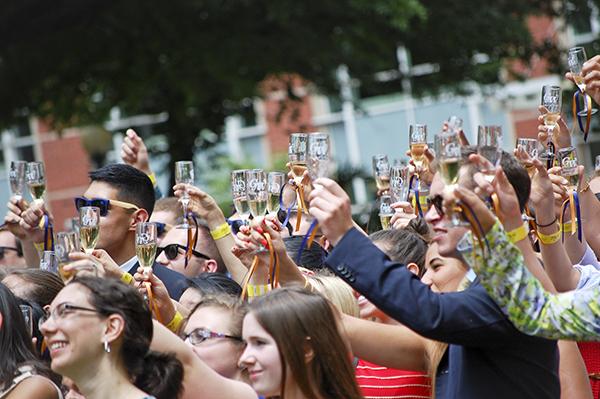Updated: Feb. 12, 2015 at 5:32 p.m.
The Council of Chairs, made up of some of GW’s most active supporters, is looking to add young alumni to its 18 advisory boards and spur donations from graduates less than 10 years out of school.
Adding younger members could help boost GW’s alumni donation rates during its $1 billion campaign, an important asset for a school trying to grow its donor base. The University is about 70 percent of the way to that fundraising goal.
The University has historically had lower alumni donation rates than its peer schools, with alumni giving back at a rate of about 10 percent. Laura Taddeucci Downs, the head of the council of chairs, is looking to change that.
“The idea is that by having young alumni representation, we can offer our young alumni volunteer leadership opportunities as well as help the University groom future philanthropic volunteer leaders,” Taddeucci Downs said.
Taddeucci Downs presented the idea at last week’s Board of Trustees meeting, and said the Council of Chairs had just recently started conversations about the idea. She said the spots would be similar to the alumni seat on the Board, and events the new members could host would be similar to young alumni events held by the GW Alumni Association.
Steve Frenkil, the president of the Alumni Association, said young alumni representatives currently serve on several groups, including the Alumni Association Board of Directors and the Luther Rice Society Advisory Council.
Young alumni made up more than a quarter of the undergraduate alumni donors in fiscal year 2014, he said.
Frenkil said young alumni can be effective fundraisers because they are “familiar firsthand with the recent great progress GW has made,” and can use that knowledge to talk about developments on campus, like new buildings or recent faculty hires.
“Young alumni, like all alumni, have experiences and perspectives from their own time at GW to draw upon in encouraging fellow alumni to participate in philanthropy,” Frenkil said.
The University has already raised $715 million toward its $1 billion goal, and promoted its interim fundraising chief to vice president for development and alumni relations during Friday’s board meeting.
The Council of Chairs will discuss adding the new alumni at its spring meeting, Taddeucci Downs said. She added that each council could decide how many alumni to add.
“I think young alumni provide a valuable insight into what motivates their peers to donate, what types of programs and activities appeal to both students and young alumni, and especially what is the best manner to communicate with our young alumni,” Taddeucci Downs said.
The Council of Chairs, made up of about 550 members, includes some of the University’s largest donor groups. Taddeucci Downs called them the “field team” for the Board of Trustees because about half of current trustees started out on a council.
Taddeucci Downs, who has set a goal of 100 percent giving for council members, said at Friday’s meeting that 86 percent of the group made donations last fiscal year – about $17.7 million total.
So far this fiscal year, Taddeucci Downs said the group has donated $8.3 million at a 57 percent participation rate.
“It’s really important that we hit this mark so that we can lead by example,” she said. “I’m optimistic that we will reach 100 percent among all the councils this fiscal year.”
Young alumni on the Council of Chairs could also help officials jumpstart alumni giving at GW, where students know they’re expected to make donations even before they graduate.
Current seniors are asked to make gifts to GW before they graduate. The Senior Class Gift Campaign set a record-high participation goal this year, hoping to receive donations from at least 60 percent of the class.
Dan Saftig, a fundraising consultant at Saftig Consulting and the chief development officer at Arizona State University, said most schools’ million-dollar donors got their start as young alumni who could only afford to make small gifts.
“The first gift may have been 50 bucks,” he said. “But universities look to engage their alumni to be involved in the university, put the university at the top of their priority list and keep it there throughout the duration of their lives.”
Colleen Murphy contributed reporting.







